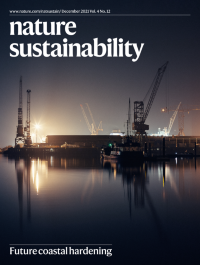Nature sustainability, December 2021
Volume 4 Issue 12, December 2021
Future coastal hardening
The world’s coasts are increasingly covered with built structures, such as piers and seawalls. Using New Zealand as a case study, Floerl and colleagues find that coastal infrastructure has replaced more than half of the coastline of 30 urban centres worldwide and forecast future hardening hotspots.
See Floerlet al.
Image: Alex Walker/Moment/Getty. Cover Design: Valentina Monaco.
Comment & Opinion
Q&A | 18 October 2021
Step back from scientific hubris
Water research has fallen into a ‘techno optimism’ that tries to solve all problems despite not asking fundamental questions, according to Stephanie Pincetl of the University of California, Los Angeles. She talks to Nature Sustainability about the challenges facing the field and science writ large.
- Ryan Scarrow
Research Highlights
Research Highlight | 15 December 2021
Narratives for change
- Monica Contestabile
Research Highlight | 15 December 2021
Photodegradable and strong plastics
- Yaoqing Zhang
News & Views
News & Views | 18 October 2021
China’s food news going forward
China’s food demand is projected to grow and reshape its production and trade relations. A new study evaluates the consequent challenges for agricultural land, greenhouse gas emissions, fertilizer and irrigation water use in China and its trading partners.
- Guolin Yao
News & Views | 07 October 2021
Land sector impacts of early climate action
Integrated assessment models are widely used to assess climate change mitigation strategies. Comparing scenarios from several integrated assessment models, a study now highlights the benefits and trade-offs of near-term mitigation to reduce mitigation challenges in the longer term.
- Göran Berndes
- Annette Cowie
News & Views | 11 October 2021
Potential impacts of an impending oil spill
Our understanding of the impacts of oil spills highlights the urgency of preventing them. A new study considers public health and other effects of an oil spill from an abandoned Red Sea tanker.
- Stephanie E. Chang
Reviews
Perspective | 16 August 2021
Personal carbon allowances revisited
Personal carbon allowances (PCAs) could support climate mitigation efforts but would need to be carefully designed to avoid impacts on Sustainable Development Goals (SDGs). This Perspective discusses why the time is ripe for reconsidering PCAs and provides a set of SDG-based design principles for the future adoption of PCAs.
- Francesco Fuso Nerini
- Tina Fawcett
- Paul Ekins
Collection:
Perspective | 30 August 2021
Reimagining safe drinking water on the basis of twenty-first-century science
A growing set of chemicals is emitted into the environment, making the protection of drinking water supplies challenging. This Perspective discusses a more holistic approach to the evaluation of drinking water quality that focuses on complex mixtures instead of a small set of regulated, well-known chemicals.
- Paul J. Ferraro
- Carsten Prasse
Research
Brief Communication | 28 October 2021
On-device lead-absorbing tapes for sustainable perovskite solar cells
Perovskite solar cells are an emerging energy technology but their sustainability is jeopardized by the presence of Pb. Here the authors introduce on-device layers that could capture over 99.9% of leaked Pb.
- Xun Li
- Fei Zhang
- Kai Zhu
Article | 18 October 2021
China’s future food demand and its implications for trade and environment
Meeting China’s growing demand for food, especially for livestock products, will have huge environmental impacts domestically and globally. This study finds large increases in land, water, fertilizer and greenhouse gas emissions that vary based on openness of trade.
- Hao Zhao
- Jinfeng Chang
- Michael Obersteiner
Article | 07 October 2021
Land-based implications of early climate actions without global net-negative emissions
Delaying climate mitigation requires large-scale carbon dioxide removal (CDR) in the second half of this century, with possible adverse effects. Under scenarios with no dependence on CDR technologies, this study examines the short- and long-term implications of climate mitigation for land-use and food systems.
- Tomoko Hasegawa
- Shinichiro Fujimori
- Keywan Riahi
Article | 21 October 2021
A global model to forecast coastal hardening and mitigate associated socioecological risks
The world’s coasts are increasingly covered with built structures, such as piers and seawalls. This study finds that coastal infrastructure has replaced more than half of the coastline associated with 30 urban centres and forecasts future hotspots using New Zealand as a case study.
- Oliver Floerl
- Javier Atalah
- Robert Major
Article | 21 October 2021
Natural infrastructure in sustaining global urban freshwater ecosystem services
Ecosystems that provide fresh water for cities also impact sediment flows, flood mitigation and hydropower provision. This Article looks at over 300 cities globally to gauge the interactions of natural ecosystems with built infrastructure.
- Min Gon Chung
- Kenneth A. Frank
- Jianguo Liu
Article | 28 October 2021
Rebound in China’s coastal wetlands following conservation and restoration
China’s coasts have become more populous and urbanized. This study finds a rebound in the area of coastal wetlands, reflecting recent conservation and restoration, with large losses between 1984 and 2011 followed by increases in saltmarsh area and stabilization of tidal flats.
- Xinxin Wang
- Xiangming Xiao
- Bo Li
Article | 11 October 2021
Public health impacts of an imminent Red Sea oil spill
The possibility of a huge oil spill off the coast of Yemen, already in crisis, is increasingly likely. This study projects the likely spill extent and impacts to public health, food, water and air.
- Benjamin Q. Huynh
- Laura H. Kwong
- David H. Rehkopf
Analysis | 11 October 2021
Nature inequity and higher COVID-19 case rates in less-green neighbourhoods in the United States
Access to green space has been a critical, and contentious, issue for neighbourhood inequality and health outcomes. This Analysis looks at how the COVID-19 pandemic interacts with availability of nature for urban residents.
- Erica N. Spotswood
- Matthew Benjamin
- Robert I. McDonald



No Comment